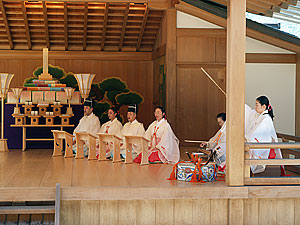
By Bill Roberts
About halfway through the ritual offering of the fruits of the sea and the earth, which Oomoto calls “kensen,” it hit me: More than half the priests at the Tottori branch on this warm Sunday in early October were young men from the Youth Division, which is for members 16 to 30 years old.
The only time I had seen so many young men serving as priests was the time I attended the Youth Division’s monthly service at Oomoto headquarters in Kameoka. There, you would expect to see all young people. When I travel to Oomoto branches around Japan I mostly see older men serving as priests, occasionally a woman or young person.
This day in Tottori was an exception.
It may seem like a so-what observation, but the fact that so many young men were priests this day – I counted at least six of the ten – is an important fact for the Tottori branch and for Oomoto more generally.
With about 10,000 member families, mostly in Japan, this small Shinto sect is counting on its young people to carry out its mission well into the 21st century. Because Oomoto does not actively proselytize – although it educates and encourages interested people – Oomoto more than most religious groups counts on its young people for its future health.
Many branches do not have a Youth Division as robust as the Tottori group. The Youth Divisions are Oomoto’s bridge to the future, and that bridge is strong in Tottori.
The participation by young priests in Tottori was also important because this was not just any “tsukinamisai,” or monthly service, but a most auspicious event – the official dedication of the Tottori branch’s recently completed new shrine.
Madame Kurenai Deguchi, who is Oomoto’s Fifth Spiritual Leader; Kunihiko Shimamoto, who is chief director of the Oomoto Foundation, the organization’s No. 2 administrative person; and other leaders attended as did visitors from Oomoto branches throughout Japan. In all, more than 300 attended, including about 100 visitors.
Volunteer priesthood
Oomoto has no professional priests. Anyone – man, woman or child (some start as young as six) – can practice and study for the priesthood and its rituals. Many Oomoto followers do, and the volunteer priesthood is one reason many people are attracted to Oomoto in the first place.
In my travels around Japan, doing interviews for my book, “A Portrait of Oomoto,” published in February 2006 by Tenseisha Press, I often heard the same story from followers: “I like Oomoto because I like being a priest.”
Oomoto followers have many opportunities to serve as priests: the monthly services at their local branches, monthly services in their home shrines for their families, and often monthly services at sub branches or for smaller neighborhood groups. Then there are weddings, funerals and other special events, plus daily morning and evening prayer services to lead at each branch. Oomoto can never have too many priests.
The opportunity for anyone to be a priest makes Oomoto unusual among religions. I have come to think of it as a form of democracy in religion.
The first time I visited Tottori, in December 2004 as part of my book research, the priests at that monthly service included two young men and a woman. I was told they had a hard time getting older men to serve as priests. That might be a good thing as it gives younger people and women the chance to participate. Many branches have an at least one monthly service a year when only women serve as priests.
During that first visit to Tottori, when I stayed in a room in the back of the old shrine for four days, the members made the initial decision to raze the old building and build a new one. The old shrine was an antiquated, mildew-infested complex converted from a 100-year-old inn built on a hot springs.
Because I was the first foreigner ever to visit the branch and was present at the creation of the new shrine, in a manner of speaking, the branch chief, Noriyuki Taga, suggested I return when the new shrine was completed. And so I attended the dedication of the new shrine on Oct. 8, 2006.
The new shrine is a beautifully architected and constructed building. I was delighted to see they had kept three features from the old shrine. Because they built on the same site, they incorporated the natural hot springs into the design; the new complex has lovely new baths. Second, they were able to keep the old teahouse, which was only 50 years old and in good condition. Using a crane, they picked up the entire structure and moved it about 30 meters, and then connected it to the new building.
Outside, they also kept two stones, which record and memorialize what Oomoto calls the “Yoshioka Prophecy.” Yoshioka Hot Springs is the name of the village where the shrine is located. Onisaburo Deguchi (1871-1948), the Co-Founder of Oomoto, thoroughly enjoyed visiting Yoshioka, and used to stay at the inn. That’s one reason Oomoto acquired it as its shrine. Onisaburo made his last visit to Yoshioka in December 1945, spending a few weeks. While he was there, he issued his last public declaration of a prophecy that he had. So, what became known as the Yoshioka Prophecy is of great importance to Oomoto followers.
Serious but fun-loving group
During my first visit to Tottori, I had an opportunity to meet with about ten members of the Youth Division one evening. They came the afternoon before the monthly service, helped prepare for the next day’s events and slept over at the shrine.
We discussed various topics, including why they were active in Oomoto and their interests in the traditional arts. They were fun-loving young people with a serious intent when it came to their spiritual lives, but not so serious as to preclude a bit of drinking at a local tavern after we finished our conversation.
I would imagine Tottori Prefecture might be a tough place for young people. Stretching along the Sea of Japan, it is a beautiful mix of farmland, mountains, and sea coast (relatively unspoiled by Japanese standards) in western Honshu, the main island. Fishing, farming and tourism are the mainstays of the economy. Mount Daisen, on the western edge of the prefecture, dominates the skyline and is a popular ski area. The prefecture is one of the largest geographically but one of the sparest in population. But there’s not much for a young person to do and few career opportunities.
On my second visit to Tottori, I met again with several members of the Youth Division, this time in a fish restaurant in downtown Tottori. Among the group was Yuji Tonai, the newly elected chief of the Youth Division, whom I had first met in 2004. He’s a construction worker studying for his supervisor’s license. A young woman, Kumiko Tanaka, whom I also met on both trips, is a sign language teacher and interpreter for the deaf. Tanaka was one of the women playing the ancient two-string “yakumogoto,” at the branch dedication service.
I’m guessing that Tonai and Tanaka represent relatively ambitious career paths for any young person in Tottori. On both trips I heard several stories about the difficulties the region’s youth have in finding meaningful work without leaving their hometown.
Taga, the branch chief, recognizes the problems his region has in keeping young people, and also knows that Oomoto’s future rests on them. He told me that no matter what the annual branch budget looked like, through thin times and fat, he always made sure the Youth Division had adequate financing, a place to meet and stay, and the autonomy to conduct their programs – priest training, the arts and fun events – as they saw fit.
A wise man, it seems to me. That might partly explain why on the day they dedicated their new shrine, Taga, who served as the chief priest, was joined by several young men.
Yuji Tonai, chief of the Tottori Youth Division, performs ritual purification with symbolic fire.
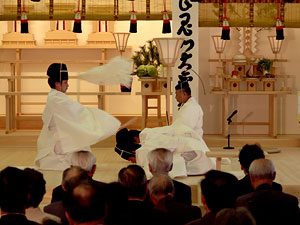
Yuji Tonai, chief of the Tottori Youth Division, performs ritual purification with symbolic fire.
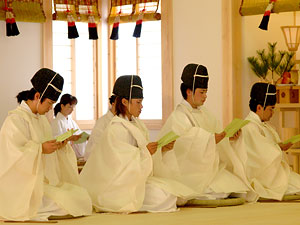
Three of the young men who served as priests at Tottori’s shrine dedication. Third from the left is Yuji Tonai.
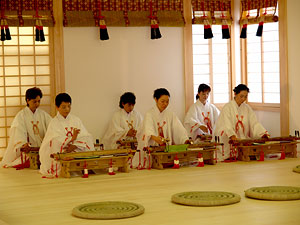
Kumiko Tanaka (middle, front row), a member of the Youth Division, plays in the yakumogoto ensemble.
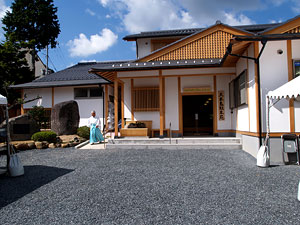
Entrance to the new shrine at Tottori branch.
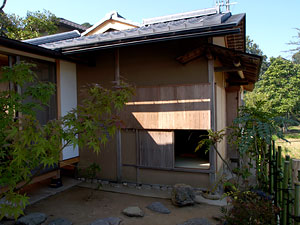
They were able to retain the old teahouse. You can see the seam where it connects to the new shrine.
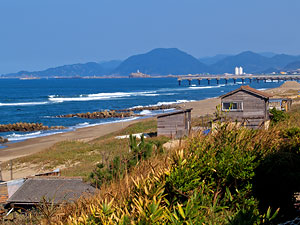
The Tottori coast line.

Mount Daisen is visible from many parts of the prefecture.
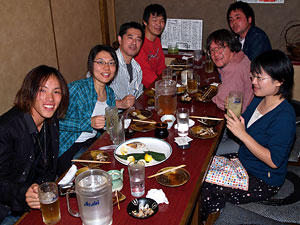
Members of the Tottori Youth Division have dinner with two Oomoto staff members, second from back on both sides of table.
New Contents Thu, May 20, 2010
- Oomoto participates in Sant’Egidio conference : Dialogue among religions and cultures : On divided island nation of Cyprus By Bill Roberts
- Photo Album : Portraits of three branches: Shoko, Tanegashima and Aomori By Bill Roberts
- Oomoto FAQ
- A Letter from Oomoto : Of mountains and myths By Bill Roberts
- Polyglot poem festival The Utamasturi is going international — what’s next? By Bill Roberts
- Ethics education program captures the spirit of Bankyo Dokon By Bill Roberts
- A Letter from Oomoto : A year’s worth of adventure in a summer of branch visits By Bill Roberts
- In Kumamoto, it’s all about water – and fire By Bill Roberts
- A speech by Nevada Taylor at the Kii Branch in Wakayama Prefecture on April 13, 2008.:An Encounter With Oomoto Through Aikido
- Utamatsuri, Poem Festival, in Tokyo(on April 17, 2008)
- A speech by Neil Ryan Walsh at the Kobe branch on Mar. 9th, 2008.:Planting the Seeds of the Soul
- Meeting with the Fifth Spiritual Leader of Oomoto, Madame Kurenai Deguchi by Neil Ryan Walsh
- A speech by Neil Ryan Walsh at the Nagoya branch on Feb. 17th, 2008.:The Japanese Arts beyond National Boundaries
- To the Oomoto branch in Nagoya: City of Eel and Toyota by Neil Ryan Walsh
- A Speech by Nissim Ben Shitrit, Ambassador of Israel on the occasion of the Oomoto Setsubun Grand Festival in Ayabe February 3rd, 2008 : Japan and Israel : Two Lands Balancing the Needs of Traditional Culture and Modern Life. r
- A permanent memorial to Onisaburo (A Speech at the Autumn Grand Festival , November 6, 2007 : )By James Parks Morton, Founder and Chair, Emeritus of The Interfaith Center of New York
- Israel, Palestine and the Power of Poetry(Oomoto believes small efforts can have lasting ripple effects on people and peace)By Bill Roberts
- “Something Great”(This genetics pioneer, a friend of Oomoto, offers a clue to the mystery of life)By Bill Roberts
- Kamishima Cleanup (Harima branch members regularly visit this sacred island to keep the shrine tidy)By Bill Roberts
- Kyotaro Deguchi was one of six recipients of the 2007 James Parks Morton Interfaith Award
What is Oomoto?
- What is Oomoto?
- Spirtual Centers
- Founders and Spiritual Leaders
- History
- Organization and activities
- Teachings and scriptures
- Art Works of Founders and Leaders
Opinions[Archive]
- Statement of regret for the outbreak of war against Iraq (March 20,2003)
- Jinrui Aizenkai dispatched the "Urgent Appeal for a World (Global) Crisis" on March 14.
Grappling with Bioethics[Archive]
- Oomoto’s support for abolishing the death penalty (12, June 2003)
- The Oomoto Foundation protests any birth of a human clone baby. (5, January 2003)
- OOMOTO'S VIEW REGARDING JAPAN’S PERMITION TO THE RESERCH OF HUMAN EMBRYONIC STEM CELLS (ES cells)(12, June 2000)
Vistor’s Review[Archive]
- A speech by Bill Roberts at the Oomoto branch in Hiroshima after its monthly service on March 18, 2007:Encounters with war and peace
- How Bankyo Dokon changed one life by Linda Macphee
- A speech by Bill Roberts at the Hokuriku (Kanazawa) branch on Dec. 3, 2006:Ritual and myth -an encounter with ‘divine madness’
- A speech by Bill Roberts at the Himeji Cultural Center on Feb. 25, 2007:Mesmerized by the Japanese Arts
- A speech by Bill Roberts at the Kobe branch on Feb. 11th, 2007.:There are just human tears and human joy
- A Speech on the occasion of the Oomoto Setsubun Grand Festival in Ayabe February 3rd, 2007 : Egypt's role in Middle East peace
- Keynote Speech for the 28th World Federation Japanese Religionists Conference for World Peace in Tokyo (at Kokugakuin University, Novermber 29, 2006):Vision for Peace in the Middle East By Dr. Munther S. Dajani, Professor Dean, Faculty of Arts, Al Quds University, Jerusalem
- A speech to the Kyoto branch:Spiritual adventures in researching Oomoto leaders
- A Speech at The Oomoto Foundation on Monday, November 6, 2006 : Jordan's role in Middle East By Samir Nouri, Ambassador of the Hashemite Kingdom of Jordan
- A letter from Oomoto:The Young People of Tottori
- A speech by Bill Roberts on the occasion of the dedication ceremony for the new shrine of Tottori Branch By Bill Roberts Oct. 8, 2006
- A speech by Bill Roberts at the Oomoto branch in Hiroshima after its monthly service on March 18, 2007:Encounters with war and peace
- How Bankyo Dokon changed one life by Linda Macphee
- A speech at Setsubun : A Portrait of Oomoto By Bill Roberts Feb. 3, 2006
- New Publication ! By Bill Roberts Feb. 3, 2006 A Portrait of Oomoto
you can read this book in html => http://www.jinruiaizenkai.jp/English/en-kolumno/en-bill/en-sugao/billbook1en.html
E-mail below to order brobert1@ix.netcom.com
Current Topics
- Prayer Offering and World Religious Forum II
- Living the art of dialogue
- Kyotaro Deguchi was one of six recipients of the 2007 James Parks Morton Interfaith Award
Books
Online Books
- Divine Signposts by Onisaburo DEGUCHI
- The Creation of Meaning by Hidemaru Deguchi
- Bankyo Dokon(Seventy years of Inter-Religious Activity at Oomoto)
- Nao Deguchi — A Biography of the Foundress of Oomoto
- The Great Onisaburo Deguchi published by Aiki News
- Bankyo Dokon Seventy Years of Inter-Religious Activity at Oomoto
- Insearch of Meaning
- Nao Deguchi A Biography of the Foundress of Oomoto
- A Portrait of Oomoto By Bill Roberts
Oomoto international Archive
- The History of Oomoto (Jan.– Mar. 1980 — Apr.– Jun. 1982)
- The Ancestors; Friends or Foes? (Apr.– Jun. 1987)
- Tsukinamisai; The Sabbath of Shinto (Jan.– Jun. 1983)
- The Poem Festival at Oomoto; An Ancient Rite Lives Again (Oct.– Dec. 1981)
- Purification of the Universe ; Oomoto's Setsubun Festival (Apr.– Jun. 1981)
Links
Flowers at Ten'on-kyo & Baisho-en (photographs)
Contact
All rights reserved : the Oomoto Foundation Produced by the Netinformational Commission
Since : Mar. 7.1998 Last Update : Thu, May 20, 2010
E-mail : webmaster@oomoto.or.jp
Top Page Nihongo Esperanto Português Roomazi



